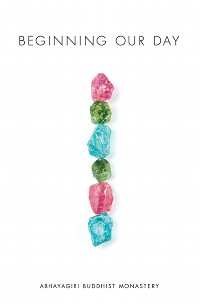Which Practice is Right for Me
อาจารย์ ปสันโน

After the meal today we will be taking formal leave of Ajahn Sucitto. Living as we do in an American Buddhist monastery, we’re in a distinct minority and rather isolated. So when visiting teachers like Ajahn Sucitto come here and talk about specific practice experiences they’ve had, it’s a precious opportunity for us. Having listened to them carefully, we can then reflect on our own experience, asking ourselves: What have I done that works? What has been beneficial? What has helped the mind relinquish its attachments and defilements? What has helped the mind become more peaceful, settled and clear? It’s not something we can learn from a book, reading about some theory and trying to make sense of it. Rather, it’s about paying attention to this element of experience—our own experiences and the experiences of others. For instance, when Ajahn Dtun visited here recently, the teachings he offered were always conveyed in terms of his own practice: “This was my experience. This was the practice I used. This is what worked for me.” After listening to teachings like that, we may be inspired to apply some of the practices described. But if we do, it’s important that we attend to what genuinely works and examine this in our daily lives, interactions, and formal practice.
To put it another way, we can ask ourselves, What is it that aligns us with Dhamma? The Buddha tells us that if something aligns or accords with the Dhamma, it’s going to increase our happiness, well-being, clarity, and understanding. The opposite is true as well. When what we’re doing increases our dukkha—our anxieties, confusion, and agitation—it’s a pretty sure bet that we’re not aligned with the Dhamma. Trying to emulate a practice used by a respected teacher may seem like a fine idea, but the test is whether applying that practice accords with the Dhamma for you—in your own, personal experience.
To employ this test skillfully takes practice, reflection, and a willingness to experiment and try things out. But it’s something we need to do. Practicing Dhamma in accordance with Dhamma—dhammānudhamma paṭipatti—is a quality that needs our close attention. In fact, it’s a key element of stream-entry. So as we go about our daily lives, as we continue to cultivate the practice, it is helpful to reflect: Does what I’m doing accord with Dhamma? What I’m saying, thinking, and feeling—does it accord with Dhamma? If we are willing to investigate these questions closely, their answers will help us clarify whether our particular practices are leading us in the right direction.
It’s important to also understand that what works for us will change, depending on conditions. For instance, just because something worked today doesn’t mean it’s going to work tomorrow, and what didn’t work in the past may work for us now. This makes it necessary for us to adapt and experiment. Often Ajahn Chah would repeat a quote from one of his teachers, Ajahn Tong Rat, who taught that the practice is very straightforward and easy: “If the defilements come high, then duck; if they come low, jump.” In other words, we’re to do whatever the situation demands—whatever works as long as it is not causing ourselves or others more suffering. This entails first asking ourselves, How might I work with this particular situation? Once we have a sense of what might be a good approach, we put it into practice, try it out, and then evaluate the results.
This all points to an ongoing, evolving relationship between the workings of our practice and the workings of our minds. It takes time to discover skillful ways of engaging with that relationship; it’s a learning process. But by sticking with this process, by taking a genuine interest in it, we can develop a good sense of what practices—whether from teachers or our own innovations—are truly beneficial, what practices accord with Dhamma, what practices genuinely work for us.
This reflection is from the newly released two part collection of Dhamma Reflections:





